This website is supported by its readers. If you click one of my links I may earn a commission. I am also a participant in the Amazon affiliates program and I will also earn a commission from qualified purchases.
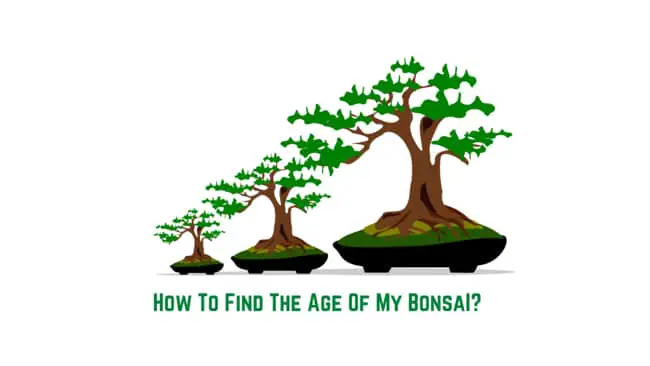
Bonsai trees and specially aged bonsai trees can sell for thousands if not hundreds of thousands of dollars. Whilst we bonsai amateurs may not ever be able to afford these expensive trees, determining the age of your bonsai tree can be important to monitor the health, value, and longevity of our trees. So how do you find the age of a bonsai tree?
To find the age for your bonsai, multiply the diameter of your bonsai by the growth rate. Alternatively to find a more accurate age count, prune a branch from your tree and count the number of rings inside. This method however may pose some damage to your tree.
So what are the other methods of determining the age of your bonsai? And do different bonsai species age differently? Keep reading to find out more!
Just a quick heads up, over the past three years of running Plantpaladin, hundreds of people have asked for product recommendations. As such, You can find my favorite indoor bonsai tree here (link takes you to Bonsaiboy), my favorite outdoor bonsai tree (link takes you to Bonsaiboy), or have a look at all the products I recommend here.
How to find the age of my bonsaI
It’s relatively easy to determine the age of a regular tree. Simply chop it down and count the number of rings it has.
Getting a good understanding of the age of a bonsai tree, on the other hand, can be a little more challenging.
After doing a lot of research, speaking to a few bonsai specialists, and even doing a quick poll of plant paladin readers I found the following methods work best to determine the age of a bonsai tree:
- Multiplying the diameter of your bonsai by its growth rate
- Counting the number of rings from a pruned branch
- Buying your bonsai from a reputable resource
- Planting your tree
- Carbon dating
Let’s explore these below in more detail.
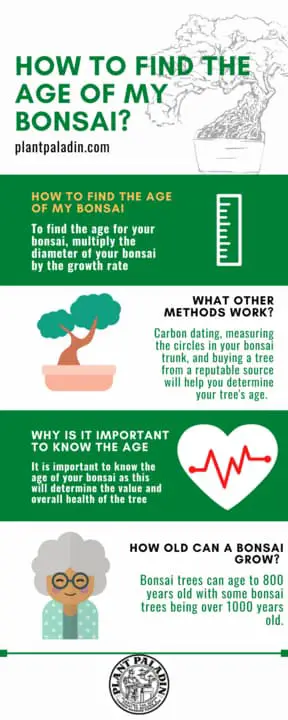
Multiply the diameter of your bonsai by its growth rate
So this first method is my preferred method of finding the age of your bonsai
What I like best about it is that, unlike the other methods, it won’t damage the tree.
Now that being said, the only downside to this method is that it can be a little inaccurate, especially if you own a rare bonsai species that grows at a different rate than some of the key ones.
The formulae you will use then is:
Diameter x growth rate of your tree per year.
Let’s break down exactly how to do this.
Step one
The first thing you need to do then is to figure out the diameter of our tree.
To find this out we first need to figure out what the circumference of our tree is.
To do this, grab a tape measure and wrap it around the trunk of your bonsai.
Aim for this measurement to be taken near the bottom of your trunk, around 1.5 inches from the bonsai topsoil, and take the measurement.
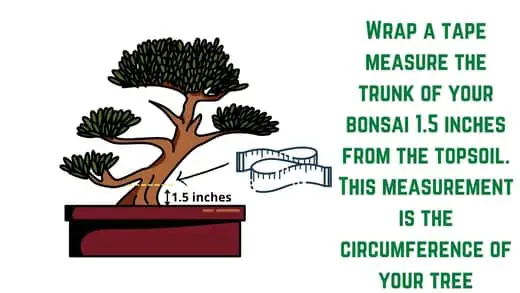
This is the circumference of your tree.
Now it’s worth noting that the larger the tree, the higher up the tree trunk you will have to measure.
For example, a small two-handed bonsai will have to be measured around 1.5 inches as mentioned above, but a large imperial-sized bonsai will have to be measured four to five inches high.
Hopefully, the table below can help:
How high up your bonsai trunk you should measure
| Classification | Size inches | Size Centimeters | Hand size | General size | How high above the topsoil should you measure |
| Keshitsubo | 1 to 3 inches | 3 to 8 centimeters | Fingertip | Tiny | 0.25 inches |
| Shito | 2 to 4 inches | 5 to 10 centimeters | One-hand | Tiny | 0.25 inches |
| Mame | 2 to 6 inches | 5 to 15 centimeters | One-hand | Small | 0.5 inches |
| Chohin | 5 to 8 inches | 13 to 20 centimeters | One-hand | Small | 1.5 inches |
| Kumono | 6 to 10 inches | 15 to 25 centimeters | One-hand | Small | 1.5 inches |
| Katade-mochi | 10 to 18 inches | 25 to 46 centimeters | Two-hand | Medium | 1.5 inches |
| Chiu or Chumono | 16 to 36 inches | 41 to 91 centimeters | Two-hand | Medium | 1.5 inches |
| Dai or Omono | 30 to 48 inches | 76 to 122 centimeters | Four-hand | Large | 2 inches |
| Hachi-uye | 40 to 60 inches | 102 to 152 centimeters | Six-hand | Large | 4 inches |
| Imperial | 60 to 80 inches | 152 to 203 centimeters | Eight-hand | Large | 6 inches |
For more information on bonsai size classification, check out the posts below:
Step two
The next step is to find the age of a bonsai is to figure out what the diameter of the tree is using the circumference measurement we just laid out.
To do this all we have to do is divide the circumference we just took and by Pi or 3.14.
This will give us an accurate number for the total diameter of our tree.
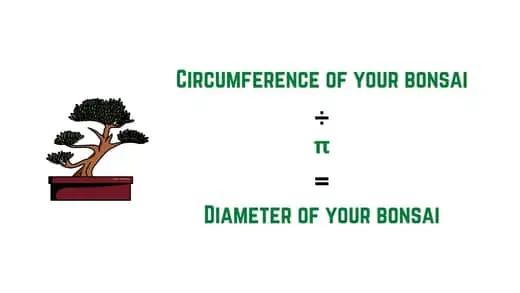
Step three
The final step of this process is to multiply the diameter we just figured out above by the growth rate of a tree.
Now as bonsai trees are not made up of one tree species but thousands of tree species, pruned and formed into bonsai trees, the growth rate of a tree will be dependent on the species you get.
Most bonsai trees however will typically grow around 2 to 36 inches per year during the spring and summer seasons.
Most bonsai owners typically tend to get one of the following trees when they first get started:
- Chinese Elm
- Ficus
- Juniper
- Jade
- Maple
To help, I’ve put together a table below
| Bonsai species | Growth type | Average growth per year |
| Chinese Elm | Fast | 12 to 36 inches |
| Juniper | Moderate | 5 to 12 inches |
| Jade | Slow | 2 to 5 inches |
| Maple | Fast | 12 to 36 inches |
| Fukien Tea | Slow | 2 to 5 inches |
| Ficus | Fast | 12 to 36 inches |
| Wisteria | Slow | 2 to 5 inches |
| Cotoneaster | Moderate | 5 to 12 inches |
| Pine (most varieties) | Fast | 12 to 36 inches |
| Azalea | Slow | 2 to 5 inches |
The growth rates laid out above however are just a guide, so to figure this out for yourself measure how much your bonsai has grown in one year to determine as accurate a growth rate as possible.
Now we know the rough growth rate for a tree, all we would have to do is multiply the growth rate by the diameter of the tree.
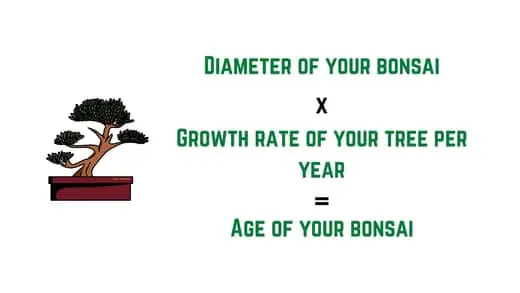
Examples of calculating growth rate using this method.
So if you decide to use this method let’s give some examples of how to work this out using three of the most common bonsai species
- Chinese elm
- Ficus
- Juniper
For all of these examples to keep things simple we will assume that these are just regular two-hand Katade-mochi or Chiu or Chumono bonsai sizes.
Calculating Chinese elm bonsai age
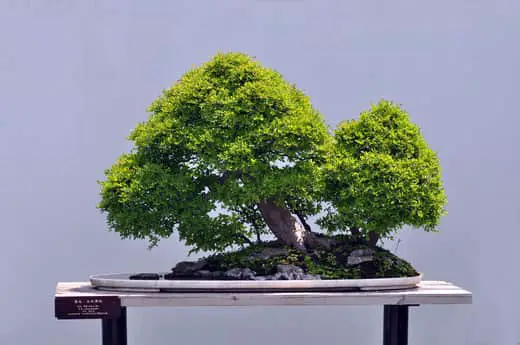
So in this example let’s say you measured the trunk of your Chinese elm bonsai which turned out to have a 15-inch circumference.
We would then divide 15inches by Pi to get the diameter of our tree which is 4.7 inches.
We would then multiply 4.7 inches by the growth rate of the tree.
For Chinese elm, this would be 12 to 36 inches per year.
So multiplying the 4.7-inch diameter by a growth rate of 12 inches we can determine that a Chinese elm this size would be around 56 years old.
Calculating ficus bonsai age
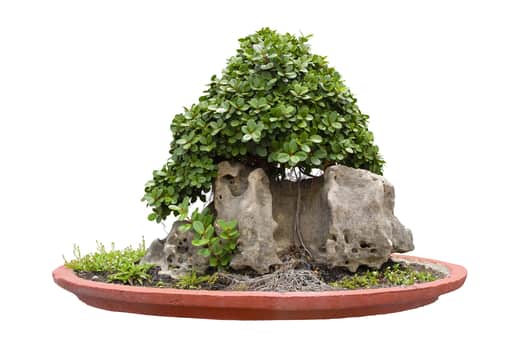
In this example let’s say we measured the trunk of our ficus bonsai which turned out to have a 9-inch circumference.
We would then divide 9 inches by Pi to get the diameter of our tree which is 2.86 inches.
We then multiply the 2.86 inches by the growth rate of the tree which for ficus trees would be 12 to 36 inches.
So multiplying the 2.86-inch diameter by a growth rate of 12 inches we can determine that a ficus this size would be around 34 years old.
Calculating juniper bonsai age
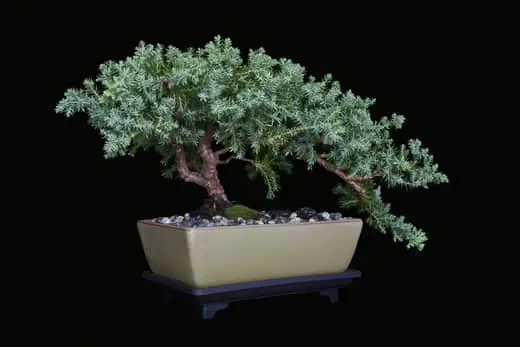
In this example let’s say we measured the trunk of our juniper bonsai which turned out to have a 4-inch circumference.
We would then divide 4 inches by Pi to get the diameter of our tree which is 1.27 inches.
We then multiply the 1.27 inches by the growth rate of the tree which for juniper trees would be 5 to 12 inches.
So multiplying the 1.27-inch diameter by a growth rate of 5 inches we can determine that a ficus this size would be around 6 years old.
Disadvantages of using this method
Typically speaking, the older a bonsai tree gets; the larger its trunk will become, making this a fairly accurate representation of the age of a bonsai tree.
Whilst this method doesn’t damage your tree there are a few key disadvantages to using this method, including:
Soil composition – soil that has a lot of aeration, moisture level, and fertilizer will mean bonsai trees will grow a lot faster than in soi that is not optimized, leading to inaccurate figures
Growth discrepancy – the size bonsai grows to vary too much from tree to tree, meaning an accurate reading will need to be taken year upon year to determine an accurate growth rate for your tree.
It does not take into account pruning – Root pruning techniques and regular defoliation can reduce the size of a bonsai trunk. This will mean that your bonsai might be a lot older or younger than first anticipated using this method.
On top of this, some smaller fingertip-sized bonsai maybe be hundreds of years old but pruned to give the illusion of a bonsai that is only 5 to 10 years old.
Determine bonsai age by measuring the rings of your tree
Counting the rings of a tree is one of the oldest and most accurate methods to devise the age of a tree.
It usually works by cutting the trunk of a tree open and counting the number of rings.
Sadly with bonsai if we were to use this method, it would likely kill our bonsai.
That being said there are a few alternatives to this method.
- Counting the rings from a pruned branch
- Removing a piece of the trunk and counting its rings/lines
Counting the rings from a pruned branch
For this method, simply prune a large branch from your tree.
Ideally, you want this to be a thick branch so it is large enough for you to count the number of rings.
You want to ensure that this branch is also taken as low down the tree as possible to ensure it works best.
In my experience, this works best when removing an overgrown sacrifice branch as these are usually grown alongside bonsai when they are young.
Simply get a pair of shears and trim the branch at a 45-degree angle like you would if you were defoliating the tree.
Then count the number of rings to get an idea of how many years old the tree is.
Counting the rings from a segment of the tree trunk
The next method is a lot more dangerous but also very accurate.
This method would require you to drill a hole directly through the middle of the trunk of your bonsai, pulling out a thin segment of the tree trunk.
You would then count the number of lines to determine the age of your tree.
I would not recommend this method, however, as if the drill hole is left open, it can start to rot or interfere with the nutrient flow of the tree.
Buying your bonsai from a reputable source
It can be difficult to determine the age of your bonsai, especially if you buy a tree from an untrusted source.
To avoid this, buy a bonsai from a respected retailer.
This will let you rest easy knowing that the bonsai tree you own is the age they say they are.
My two personal favorite bonsai retailers in the US and the UK have to be:
- Eastern Leaf (North America)
- Herons Bonsai (UK)
Both of whom I found to be genuine, honest, and most importantly, trustworthy.
Plant your tree
As bonsai requires a lot of patience most of us bonsai enthusiasts are in it for the long term.
One surefire way to guarantee the age of your bonsai is by growing them from scratch.
It’s relatively easy to grow bonsai from seedlings or even large cuttings.
That being said this method does require years if not decades of patience so won’t be for everyone.
Carbon dating
Finally, the most accurate method of determining a bonsai tree’s age is to carbon date your tree.
This method again won’t damage your bonsai.
It is however rather expensive.
As such it is unlikely you will be able to do this method yourself without seeing a specialist so I’d only recommend it if you have a lot of spare time and a big wallet.
Bonsai deadwood techniques and age
Now one tip you need to know when determining the age of your bonsai is bonsai deadwood techniques and how they relate to the age of your bonsai.
Bonsai deadwood is a technique used in bonsai to give an artificially aged look for your tree – usually done by using lime sulfur.
This method is common in things like jin or sabamiki.
Deadwood like this can give the illusion that your tree is a lot older than it looks, so if your bonsai was purchased with deadwood, try to determine if this was created or occurs naturally.
How old can a bonsai grow?
Bonsai trees can age to 800 years old with some bonsai trees being over 1000 years old. Most bonsai trees will typically age to around 100 to 200 years if cared for properly.
Bonsai trees usually grow a lot more than older trees because regular trees will use their energy to grow taller.
Once this has been achieved they cannot maintain their height for too long as they eventually die.
Bonai on the other hand rarely grow tall and so their energy is focused on maintaining their age for as long as possible.
To find out more about this – check out my post here on how long bonsai trees live.
| Plant breed | Average Lifespan |
| Japanese Maple | Over 100 years |
| Chinese Elm | Over 100 years |
| Ficus | 20 years in the wild but have been known to live for over 100 years for bonsai |
| Bodhi Tree | Average 100 years with older species living for thousands of years |
| Common Beech | 300 years – 1000 years |
| Boxwood | 20 – 30 years with some bonsai reaching 100 years old |
| Juniper | 200 years |
| Jade | 70 – 100 years |
| Crape Myrtle | 50 years |
| Fukien Tea | 100 years |
Are large bonsai always older?
Typically most larger-sized bonsai such as imperial bonsai will be older than smaller bonsai such as fingertip-sized bonsai. Regular bonsai pruning however can mean that you can have smaller bonsai that are far older than they appear.
Whilst fingertip-sized bonsai can usually be achieved in 2 to 3 years by most bonsai owners, some choose to keep and maintain bonsai this size for decades meaning it can be tough to come up with a solid correlation between the size of a tree and its age.
Why is it important to know the age of your bonsai trees?
It is important to know the age of your bonsai as this will determine the value and overall health of the tree. Older bonsai are typically more expensive than younger bonsai. Older bonsai are also more susceptible to fungal disease and insect infestation.
Determining your bonsai trees’ age will allow you to also care for them better, with some pests such as slugs or birds attacking them frequently the older they are.
Typically after 20 years, it will be safe to plant bonsai in the ground with the roots now being maintained in size – this means you won’t have to worry about your bonsai turning into a regular tree.
How much does a bonsai grow in one year?
Bonsai trees will typically grow between 5 to 36 inches per year during the spring and summer months. This depends on the type of bonsai. Fast-growing species include Chinese elms. Slow-growing species include jade.
How to find the age of my bonsai – study
Now I didn’t just want to give my opinion about how to work out the age of a bonsai tree.
As such, I visited my local botanical gardens – here is what tone of their employees hey had to say:
“The best way to determine the age of a bonsai tree is just to keep note of its growth year on year – it’s an arduous process but tallying the years you’ve kept your bonsai against how old they were when you got them is the best way. The last thing you want to do is damage the tree”
I also did a quick survey of ten plant paladin readers to get an idea of how they determine the age of their trees.
These were the results:
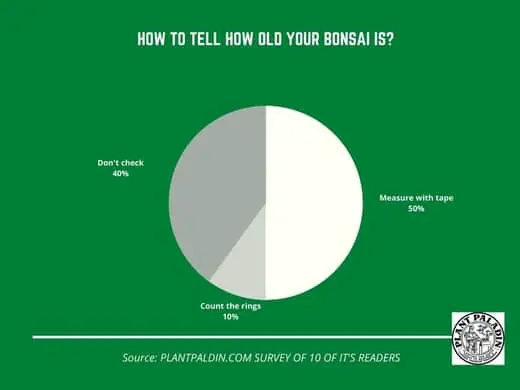
My top picks for the gear you will need!
So like I mentioned earlier, over the past three years of running PlantPaladin, hundreds of people have asked me for my recommendations on the best bonsai gear on the market.
Having spent thousands of dollars on bonsai items these past few years and tested at least 100 bonsai-specific products, I’ve listed my favorite products below – All of which I highly recommend and think you can get great value.
They can purchase directly by clicking the link to take them to Amazon.
Bonsai Tool Set: One of the significant challenges I’ve had is finding a toolset that was not only durable but didn’t break the bank. SOLIGT has recently developed a fantastic bonsai tool set that covers all the tools you need to trim, prune, and repot your trees. – You can grab it here.
Complete Bonsai Set: Many of you will want to grow your bonsai trees entirely from scratch, but finding the varicose seeds, pots, and other items in one place can be challenging. Leaves and Sole then have created a complete bonsai set that I’ve personally used that ticks all the boxes. You can grab it here.
Bonsai wire: The number of times I’ve run out of wire for my bonsai or purchased cheap bonsai wire that doesn’t do the job is embarrassing for me to admit. After a lot of trial and error, I found that using Hotop’s aluminum bonsai wire is one of the best options on the market. This can easily be used for both indoor and outdoor bonsai. You can grab it here.
This post was written by Fehed Nicass who has been passionate about bonsai for over 2 years.
